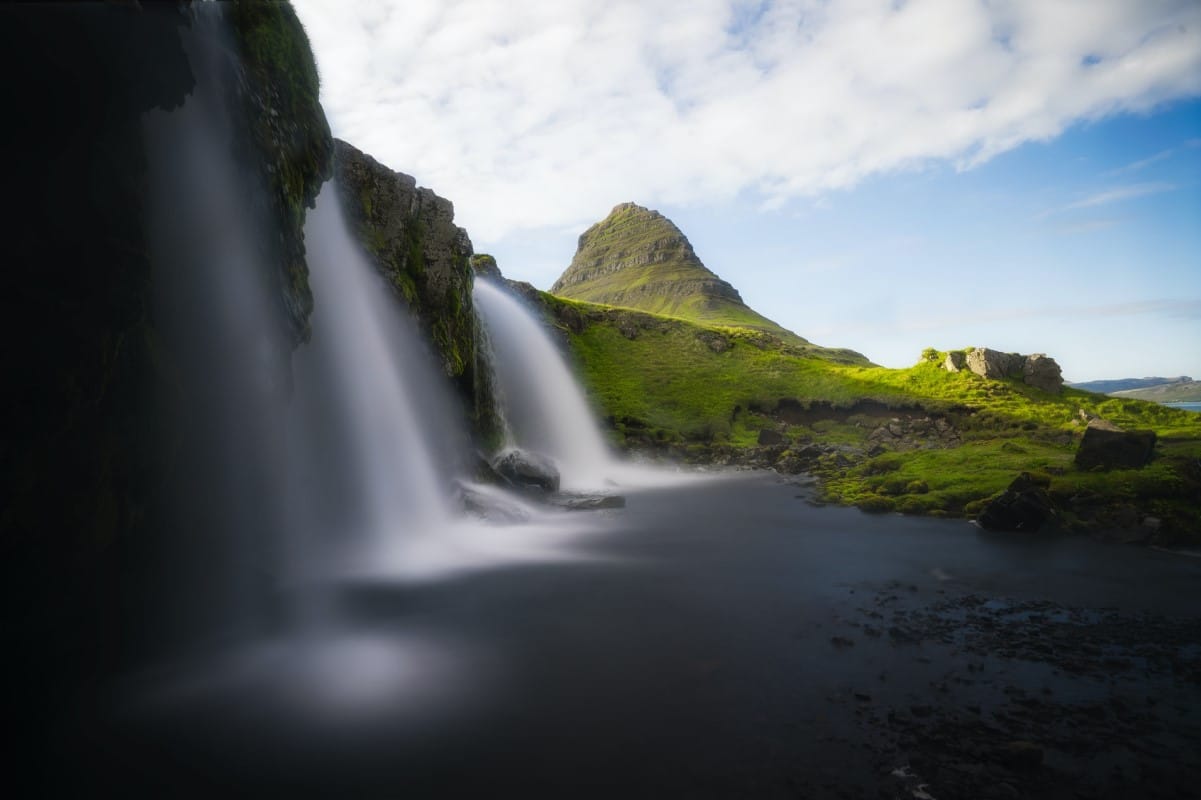Iceland is a land of stunning natural beauty, dramatic landscapes, and unique cultural experiences. From towering glaciers to active volcanoes to bubbling geothermal pools, this country has something for everyone.
With so much to see and do, it can be hard to know where to start. That’s why we’ve put together a list of must-see attractions and activities in Iceland. Whether you’re seeking adventure, relaxation, or culture, this list will give you a solid start to help you make the most of your trip. From the iconic Golden Circle to off-the-beaten-path destinations, we’ve got you covered.
Pack your bags, grab your camera, and get ready for an unforgettable journey through Iceland’s most breathtaking sights and experiences!
Explore the Golden Circle
The Golden Circle is a 300 km loop connecting three very popular attractions in Iceland: the Gullfoss waterfall, Geysir Geothermal area, and Thingvellir National Park. Thingvellir is the closest to the capital Reykjavik, approximately 50 kilometres, while the Gullfoss is furthest at 120 kilometres from Reykjavik.
Thingvellir
Thingvellir National Park is a UNESCO World Heritage Site and has rich geology throughout the park as a result of being between tectonic plates. It also contains Thingvallavatn, the largest natural lake in Iceland.

Amongst the top attractions is the Kerid Crater, a picturesque volcanic crater lake.

The Silfra fissure is a ravine created by the separating tectonic plates and some guides can take you snorkeling here (must be PADI certified).
There is a stunning valley called the Almannagja gorge which contains Oxararfoss waterfall and was a shooting location in the HBO series Game of Thrones.
Top Detours on the Golden Circle Route
- Skalholt, Iceland’s first town, which has a picturesque cathedral.
- Thjordsardalur Valley.
- Helgufoss and Thorufoss waterfalls.
- Fridheimar, a tomato, cucumber, and horse farm on Route 35. A great place to stop for tomato soup and home-baked bread.
- Secret Lagoon in Fludir, the oldest swimming pool in Iceland. Entry cost is a fraction of the Blue Lagoon at 3000 ISK.
- Fontana Geothermal Baths, a spa in the town of Laugarvatn, on the way from Thingvellir to Geysir. It has three steam rooms and a traditional wooden Finnish sauna with views of surrounding nature, bookable for 4,500 ISK. You can book a rye bread tour as well for 2,500 ISK.
You should plan to spend a minimum of a half day exploring the Golden Circle, or around six hours.
Feel the Heat at Hveradalir Geothermal Area

Kerlingarfjoll is a mountain range in the highlands of Iceland. Located within the highlands is Hveradalir, a geothermal ‘wonderland’. This geothermal area is famous for its colorful hot springs, steaming vents, and bubbling mud pots. It is situated between two glaciers, Hofsjökull and Langjökull, and is accessible via a winding mountain road (F347).
The Hveradalir Geothermal Area is home to several geothermal hot springs, each with a unique color and temperature. The bright blue pool of the Hveravellir hot spring and the orange and red colors of the Stórihver hot spring are among the most popular sights. Visitors can also take a dip in the natural hot springs for a relaxing soak while enjoying the stunning views of the surrounding landscape.
The area is also home to a range of hiking trails, ranging from easy walks to more challenging treks. The Hveradalir valley hike is a popular option, leading visitors through a surreal landscape of steam vents, bubbling mud pots, and colorful hot springs. The hike takes around 3-4 hours and offers incredible views of the geothermal area and the surrounding mountains.
In addition to the geothermal wonders, the Hveradalir Geothermal Area is also known for its unique flora and fauna. Visitors may spot arctic foxes, reindeer, and a variety of bird species, including ptarmigans and snow buntings. The area is also home to a variety of wildflowers, including the rare moss campion.
Overall, the Hveradalir Geothermal Area is a must-visit destination for nature lovers, hikers, and anyone seeking a unique geothermal experience. With its stunning landscapes, diverse wildlife, and unique geothermal features, this area promises an unforgettable adventure.
Getting to Hveradalir Geothermal Area
Getting to Hveradalir is a bit tricky, however. You must venture down F35 (the primary F-road in Iceland), and then take F347 to get to Kerlingarfjoll. F-roads do have rules around what types of vehicles can drive them (4x4s) and depend on conditions as well.
The designated parking lot is past the Kerlingarfjöll Mountain resort. From the lot, there are a number of trails that you can follow to explore the geothermal area. If you are short on time as we were, you can just go up 4 or 5 hills to take in all the different views to be had.
Diamond Beach and Iceberg Lake

Diamond Beach is a stunning black sand beach located on the South Coast of Iceland near Jökulsárlón Glacier Lagoon. The beach gets its name from the sparkling icebergs that wash up on the shore, which are in stark contrast to the dark volcanic sand. These icebergs come from the nearby Breiðamerkurjökull glacier, which breaks off into the Jökulsárlón Glacier Lagoon and eventually floats out to sea.
The icebergs are sculpted by the waves and wind, creating a unique and constantly changing landscape. The beach is a popular spot for photographers, as the contrast between the black sand and icebergs creates a stunning backdrop for photos.

Iceberg Lake, also known as Jokulsarlon Glacier Lagoon, is located just next to Diamond Beach. It is a large glacial lake filled with icebergs of all shapes and sizes. The lake is fed by the Breiðamerkurjökull glacier and is one of Iceland’s deepest lakes, reaching depths of up to 250 meters (820 feet). The icebergs in the lake can be quite large and are often a vivid blue color, caused by the reflection of sunlight off the dense ice.
Visitors can take a boat tour of the lake or simply enjoy the stunning views from the shore. The lake is also home to a variety of marine life, including seals, which can often be spotted lounging on the icebergs.
Relax in a Natural Hot Pool or Lagoon
Iceland is known for its geothermal activity, which has given rise to numerous natural hot pools scattered throughout the country. These hot pools are heated by underground geothermal activity and are a popular destination for tourists and locals alike.

The hot pools are often surrounded by beautiful natural scenery such as mountains, glaciers, and forests, making them a relaxing and picturesque place to soak. The temperature of the hot pools can vary depending on their location and the time of year, but most are comfortably warm and range from around 36°C to 40°C (96°F to 104°F).
One of the most famous hot pools in Iceland is the Blue Lagoon, which is located in the Reykjanes Peninsula, close to the Keflavik International Airport. It is a man-made pool that is fed by water from a nearby geothermal power plant. The milky blue water of the Blue Lagoon is rich in minerals such as silica and sulfur, which are said to have healing properties for the skin.

Other popular hot pools in Iceland include the Secret Lagoon in Fludir (very close to Reykjavik), the Myvatn Nature Baths in North Iceland, and the Seljavallalaug pool in the South of Iceland. Many of these hot pools are located off the beaten path and require some hiking or driving to get to, but they are worth the effort for the unique experience of soaking in natural hot springs amidst Iceland’s stunning landscape.
Go Puffin Spotting at the Cliffs of Látrabjarg
One of the largest puffin colonies in the world resides in Iceland (between 8 and 10 million), where the cliffs, rugged landscape, and nearby ocean provide ideal nesting sites for the birds.

Puffins typically arrive in Iceland in late April or early May and stay until August or September. During this time, they mate and raise their chicks, which usually fledge in early August.
Visitors to Iceland enjoy taking puffin-watching tours, where they can see these charming birds up close and learn more about their behavior and habitat. There are several good spots to go puffin-watching, including the Westman Islands, Dyrhólaey, and Látrabjarg.
The Latrabjarg cliffs are a good spot in particular, and indeed even if you aren’t lucky enough to see any birds, the view from the cliff itself is pretty spectacular.

Latrabjarg is no easy task to get to however, as it is situated at the westernmost point of Iceland, in the Westfjords region. It is one of the largest bird cliffs in the world, with a length of about 14 km and a height of up to 440 meters. The cliff is home to many other seabird species as well, including razorbills, guillemots, and kittiwakes, among others.
It’s important to note that while puffins are abundant in Iceland, they are still considered a vulnerable species due to threats such as climate change and overfishing. Visitors to Iceland are encouraged to observe these birds from a respectful distance and avoid disturbing their nesting sites.
Photograph One of Iceland’s Countless Waterfalls
You can’t go to Iceland without visiting at least one epic waterfall (I think we stopped at about 10 on our last trip to Iceland).

Waterfalls are one of the most notable topographic features of Iceland. No matter what area of Iceland you decide to venture to, you won’t be far from a waterfall.
Here are some of the most famous waterfalls in Iceland:
- Gullfoss – Located in the southwest of Iceland, the Gullfoss waterfall is one of the most popular in Iceland. Its name means “Golden Falls” in Icelandic, and it is known for its two-tiered drop and the rainbow that often appears above it.
- Seljalandsfoss – Located in the south of Iceland, Seljalandsfoss is a unique waterfall that visitors can walk behind. It drops 60 meters (197 feet) from a cliff, and the trail that leads behind it provides incredible views of the surrounding landscape.
- Skógafoss – Another popular waterfall in the south of Iceland, Skógafoss drops 60 meters (197 feet) and is known for the mist that creates rainbows in the sunlight. There is a staircase that visitors can climb to the top for a different perspective.
- Dettifoss – Located in the northeast of Iceland, Dettifoss is one of the most powerful waterfalls in Europe. It drops 45 meters (147 feet) into a canyon, and the spray from the falls can be seen from a distance.
- Svartifoss – Located in Vatnajökull National Park in the southeast of Iceland, Svartifoss is known for its unique basalt column formations surrounding the falls. It drops 20 meters (66 feet) and is a popular hiking destination.
These are just a few of the many beautiful waterfalls in Iceland, and there are many more to discover for visitors who explore this breathtaking country. Take your pick!
Experience the European Culture of Reykjavik
If you’re visiting Iceland, you’ll no doubt budget to spend some time in the capital of Reykjavik, the largest city in Iceland. Reykjavik is a vibrant and cosmopolitan city that blends modern amenities with a rich cultural heritage. It is surrounded by stunning natural scenery, including the Atlantic Ocean and mountains.
Reykjavik is home to many cultural attractions, including museums, galleries, and theaters. The National Museum of Iceland showcases the country’s history and culture, while the Harpa Concert Hall and Conference Center host a variety of music and cultural events. The city also boasts many street art and sculpture installations, adding to its vibrant artistic scene.
The city hosts several cultural festivals throughout the year, including the Reykjavik Arts Festival, Iceland Airwaves, and the Reykjavik International Film Festival. The city is also home to many independent artists, writers, and musicians, adding to its creative and eclectic atmosphere.
Literature is another important aspect of Reykjavik’s culture, with Icelanders’ strong tradition of storytelling and poetry. Reykjavik is home to several independent bookstores, and the city hosts an annual literary festival, the Reykjavik International Literary Festival.
Food and drink are also an essential part of Reykjavik’s culture. The city’s culinary scene is influenced by traditional Icelandic cuisine, which includes seafood, lamb, and dairy products, as well as international cuisine from all over the world. Reykjavik is home to several world-renowned restaurants, including the Michelin-starred Dill, as well as many popular bars and cafes. Lastly, the Icelandic hot dog is a staple unlike any hot dog you’ve had before!
For other ideas on what to do while in Reykjavik, see our article: Top 5 Things to Do in Reykjavik.
Wind Through the Westfjords
The Westfjords is a region in the northwest of Iceland, known for its stunning and dramatic landscapes, remote wilderness areas, and rich cultural heritage. It is a rugged and sparsely populated area, characterized by steep mountains, deep fjords, glaciers, hot springs, and vast stretches of untouched wilderness.

The Westfjords is a popular destination for outdoor enthusiasts, with opportunities for hiking, camping, bird watching, fishing, kayaking, and whale watching. The region is home to several national parks, including the Hornstrandir Nature Reserve, which is only accessible by boat and offers some of the most remote and pristine wilderness areas in Iceland.
The Westfjords is also rich in history and culture, with several small towns and villages that have preserved their traditional way of life. The region is home to a vibrant arts and crafts scene, with local artisans creating everything from traditional Icelandic sweaters to handcrafted ceramics and jewelry.
The Westfjords are a more difficult part of Iceland to get to, and require a few days to explore fully, but are definitely worth it for their rugged, untamed beauty. On my recent trip to Iceland, we were able to explore only a small portion of the fjords, but it was one of the foremost highlights of the trip and definitely has me itching to make it back as soon as I can.
Admire the Landscape at Landmannalaugar
Landmannalaugar is a region in the highlands of Iceland that is known for its stunning and unique natural landscapes. Located in the southern part of the country, Landmannalaugar is a popular destination for hiking, camping, and sightseeing, attracting thousands of visitors every year.
The area is characterized by its colorful mountains, geothermal hot springs, and rugged terrain. The mountains in Landmannalaugar are made of rhyolite, a volcanic rock that has been weathered over time to produce an array of vibrant colors, including shades of red, green, yellow, and purple. These colorful mountains create a stunning backdrop for the area’s hiking trails and camping sites.

Landmannalaugar is also known for its geothermal hot springs, which are a popular spot for visitors to relax and soak in the warm water. The hot springs are fed by a nearby volcano and range in temperature from 36 to 40 degrees Celsius.
The area offers numerous hiking trails that range in difficulty from easy to challenging. The most popular hike is the Laugavegur trail, a 55-kilometer trek that takes hikers through some of Iceland’s most stunning landscapes, including glaciers, waterfalls, and volcanic craters.
In addition to hiking and soaking in hot springs, visitors to Landmannalaugar can also enjoy other outdoor activities such as horseback riding, mountain biking, and fishing. The area is accessible by a rough mountain road that is only open during the summer months, making it a popular destination for those seeking an adventure in Iceland’s rugged and remote wilderness.
There are three main roads leading to Landmannalaugar. The easiest and most popular one is F208 from the north. The second easiest route is the F225 from the west (close to mt. Hekla). The third and hardest, but probably the most scenic is F208 from the south, entering directly from highway number 1.
You will NEED to have a 4×4 vehicle before attempting to drive the roads of Landmannalaugar, and should be comfortable taking river crossings as well. Certain rental companies won’t insure their vehicles for this type of driving, so there are some logistics to be handled before exploring Landmannalaugar, but it is definitely worth the effort in our opinion!
Marvel at the Majestic River Canyon, Fjaðrárgljúfur
Fjaðrárgljúfur is a canyon in south-east Iceland, located near the small village of Kirkjubæjarklaustur. The canyon is approximately 2 kilometers long and up to 100 meters deep and was formed by a glacial river that carved its way through the soft volcanic rock over millions of years.
The canyon is known for its spectacular and otherworldly landscapes, with steep walls and winding paths that offer breathtaking views of the surrounding area. The river that flows through the canyon is crystal-clear and adds to the beauty of the scenery.
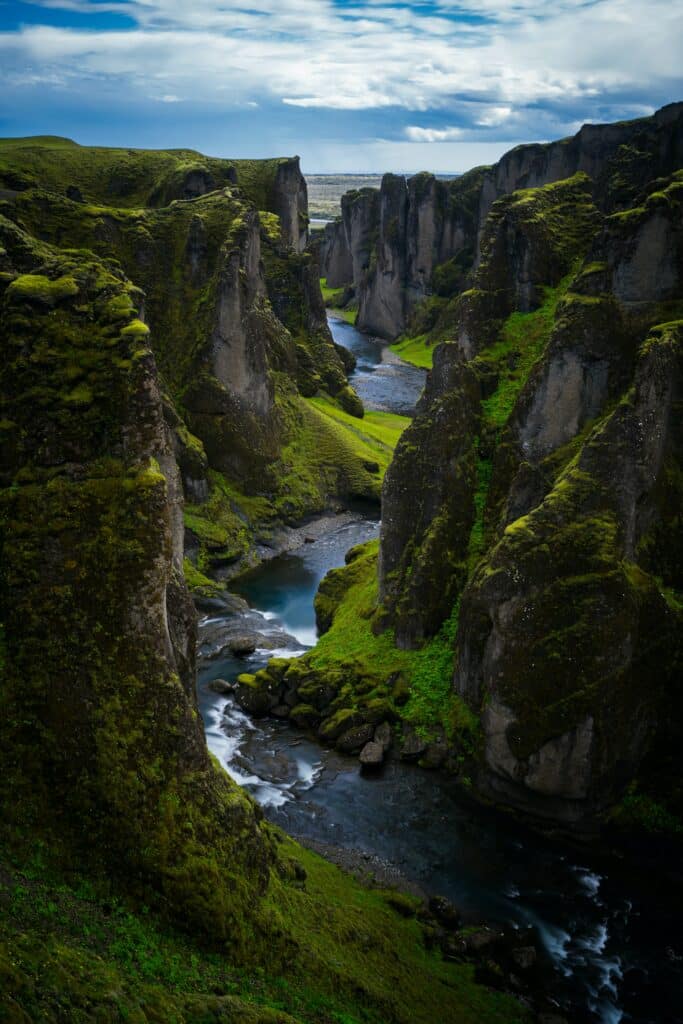
Fjaðrárgljúfur has become a popular destination for visitors to Iceland, especially after being featured in a music video by the band “Of Monsters and Men.” The canyon offers several hiking trails that range in difficulty, from short walks to longer treks that take visitors deeper into the canyon.
In recent years, Fjaðrárgljúfur has experienced some damage due to over-tourism, and as a result, some parts of the canyon may be closed to visitors. It is important for visitors to follow guidelines and respect the natural environment to help preserve this beautiful natural wonder for future generations to enjoy.
Hike the Hornstrandir Peninsula
The Hornstrandir Peninsula is a remote and rugged wilderness area located in the western corner of northern Iceland (the Westfjords). It is only accessible by boat, and there are no roads or permanent settlements within its boundaries. The peninsula is characterized by steep mountains, deep fjords, and dramatic sea cliffs, making it a popular destination for hikers and adventurers.
The hike on the Hornstrandir Peninsula is a challenging and rewarding experience that typically takes 4-6 days to complete. The trail follows a rough and rocky coastline, passing through valleys and over mountain passes. Hikers must be prepared for steep climbs, rocky terrain, and unpredictable weather conditions, as the area is known for sudden storms and high winds.
The scenery on the Hornstrandir Peninsula is spectacular, with panoramic views of the ocean, glaciers, and rugged coastline. Wildlife is abundant, and hikers may have the opportunity to see Arctic foxes, seals, whales, and a variety of bird species.

Accommodation on the hike is primitive, with no established campsites or lodges along the route. Hikers must bring their own tents and supplies, as well as a reliable navigation system and emergency equipment. Due to the remote and challenging nature of the area, it is recommended that hikers be experienced and well-prepared before embarking on the hike.
On the surface, you must be borderline clinically insane to want to do this crazy hiking trip. Naturally, it is a bucket list item for me, and one of the reasons I hope to make it back to Iceland!
Visit the Westman Islands
Vestmannaeyjar, or the Westman Islands, are located on the southern coast of Iceland and can be reached by a two-hour drive and a 40-minute ferry ride from Reykjavík (you can take your car or go as a foot passenger).
Heimaey is the largest and only inhabited island among the 15 islands in the archipelago. The island is predominantly made up of rocky beaches and undulating green hills, and it is currently home to a population of approximately 4,000 people.
Fun fact: Heimaey is one of the best places to see puffins, and also one of the only places where locals still hunt puffins in Iceland!
The Westman Islands, or Vestmannaeyjar, offer a variety of activities and attractions for visitors to enjoy. Here are some of the top things to do on the Westman Islands:
- Visit Eldfell: The Eldfell volcano erupted in 1973, creating a new crater and changing the landscape of Heimaey island. Visitors can hike to the top of the volcano and enjoy stunning views of the island and the surrounding ocean.
- Explore Sæheimar Aquarium: This aquarium features a variety of marine life found around the Westman Islands, including puffins, seals, and other sea birds. It’s a great place to learn about the local wildlife and ecosystems.
- Take a boat tour: Boat tours around the Westman Islands offer the opportunity to see puffins, whales, and other sea life up close. Some tours also include visits to nearby islands and natural attractions.
- Visit the Westman Islands Museum: The museum showcases the history and culture of the Westman Islands, including exhibits on the Eldfell eruption and the fishing industry that is central to the islands’ economy.
- Walk along Stórhöfði: This scenic cliff offers breathtaking views of the ocean and surrounding islands. It’s also a popular spot for bird watching, particularly during puffin breeding season.
- Go on a hiking or biking tour: The Westman Islands have several hiking and biking trails that allow visitors to explore the island’s natural beauty and wildlife.
- Relax on the beach: The Westman Islands have several beautiful beaches, including the black sand beach at Stórhöfði, that offer a tranquil spot to relax and enjoy the scenery.
Lastly, definitely don’t leave the island without trying some incredible local cuisine. The restaurants on Heimaey offer a range of delicious and authentic Icelandic cuisine, featuring fresh and locally sourced ingredients. Here are a few ideas:
- Gott: This restaurant is located in the heart of Heimaey and offers a cozy and intimate atmosphere. The menu features a range of dishes made with local ingredients, including fresh seafood and Icelandic lamb.
- Slippurinn: Slippurinn is a farm-to-table restaurant located in an old shipyard on Heimaey. The menu changes frequently and is based on seasonal and local ingredients, including fish and meat from the surrounding waters and fields.
- Fjörukráin: This restaurant is located in a charming, historic building and offers a range of dishes made with local ingredients, including fresh fish and Icelandic lamb. The menu also includes vegetarian and gluten-free options.
Tour Iceland on Horseback
Horse riding tours are a popular activity in Iceland, as Icelandic horses are a unique breed known for their sure-footedness, endurance, and friendly disposition. These tours can range from a few hours to several days and can take visitors through a variety of landscapes, including rugged mountains, lava fields, and scenic coastlines. Many tours are suitable for riders of all skill levels, from beginners to experienced equestrians.

Some horse riding tours in Iceland also include other activities, such as visits to natural attractions like waterfalls and hot springs, or opportunities to learn about Icelandic culture and history from knowledgeable guides.
If you are interested in taking a horse riding tour in Iceland, it is recommended to do some research and read reviews of different tour operators to find a reputable and experienced company that offers the type of tour you are looking for.
Visit the South Coast: Dyrholaey, Black Sand Beach, and Vik
If you visit south Iceland, there are several closely situated points of interest that you can’t miss: Dyrholaey, Black Sand Beach, and Vik.
Dyrhólaey is a promontory (point of high land) and popular tourist destination because of its natural beauty and unique geological features. The headland is approximately 120 meters high and consists of volcanic rock formations, including basalt columns and sea stacks.
The most famous sea stack is called “Lighthouse Rock” and has a lighthouse built on top of it. From the top of the promontory, visitors can enjoy panoramic views of the Atlantic Ocean, the black sand beaches, and the surrounding countryside. Dyrhólaey is also home to a variety of bird species, including puffins, guillemots, and razorbills, which nest on the cliffs during the summer months.
The area around Dyrhólaey is protected as a nature reserve, and visitors are encouraged to follow responsible tourism practices to help preserve the natural environment.
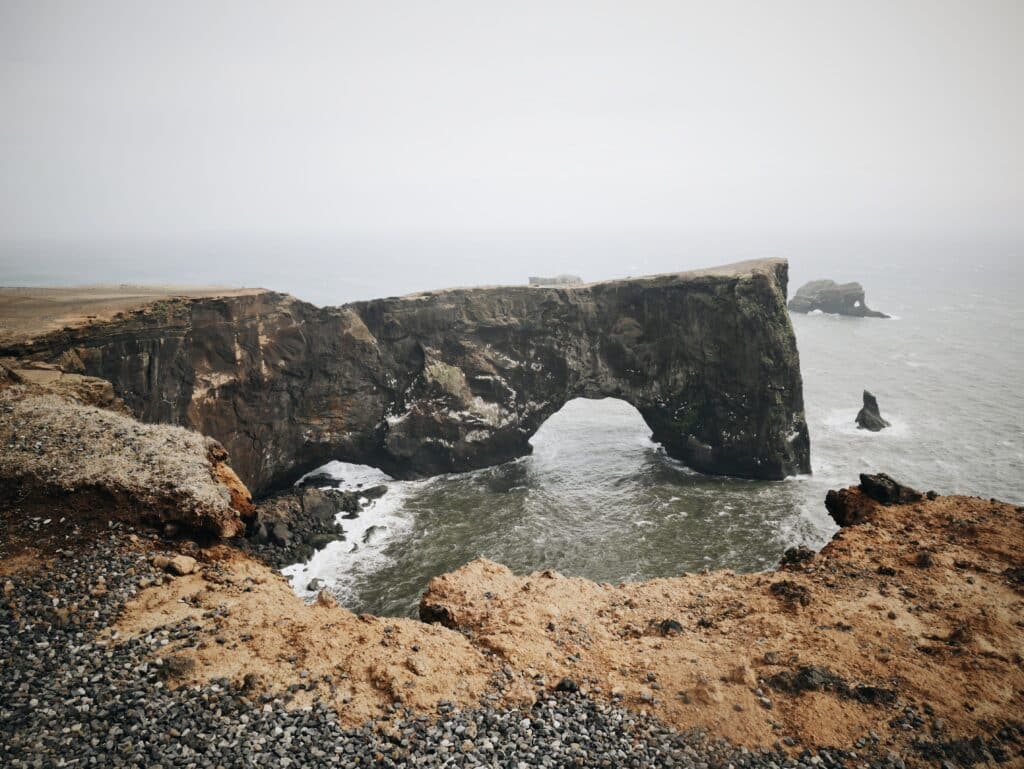
Vík í Mýrdal, commonly known as Vík, is a small village located on the south coast of Iceland, and is situated just east of Dyrholaey and the black sand beach. Vík is one of the southernmost villages in Iceland and is approximately 186 km (116 miles) southeast of Reykjavík, the capital city.
The village itself is also home to several shops, restaurants, and accommodations, making it a convenient base for exploring the surrounding area and attractions. The village is home to a historic church, Vikurkirkja, which dates back to the late 19th century. The area around Vík is also known for its folklore, including tales of trolls and hidden treasure.
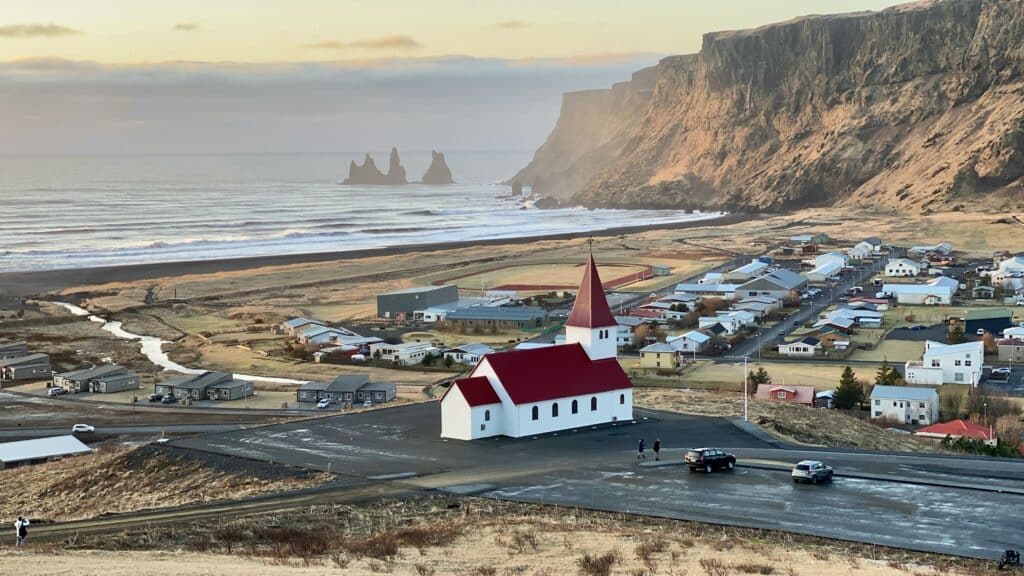
Iceland has several black sand beaches, one of the most well-known being Reynisfjara, to the east of Dyrholaey and just a short walk from Vik. The black sand is formed due to eroded volcanic material such as lava, basalt rocks, and other dark-colored rocks and minerals. Reynisfjara is known for its dramatic and stunning landscape, which includes black sand, basalt columns, and towering sea stacks.
It’s important to note that Reynisfjara can also be a hazardous place due to the strong waves and currents in the area. Visitors should always take care when exploring the beach and follow any posted warnings or instructions.
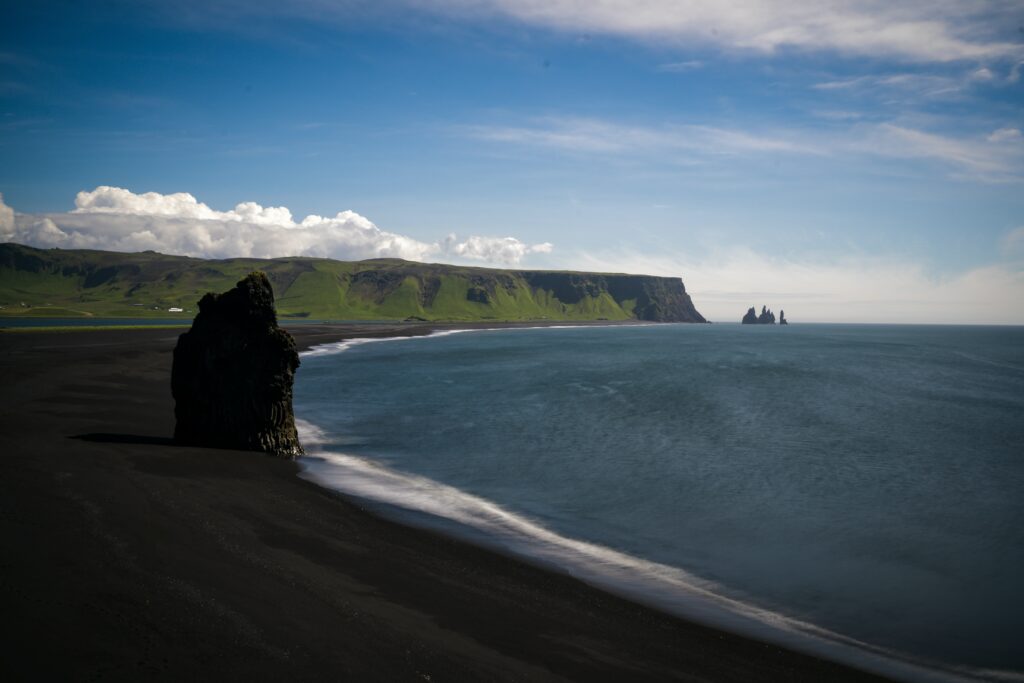
If you’re venturing through southern Iceland, definitely don’t miss these three awe-inspiring spots!
Walk Across a Glacier
Glacier walks are a popular outdoor activity in Iceland, where you can explore some of the country’s stunning glaciers and ice formations. Iceland has several glaciers, and many tour companies offer a guided glacier hike for visitors.
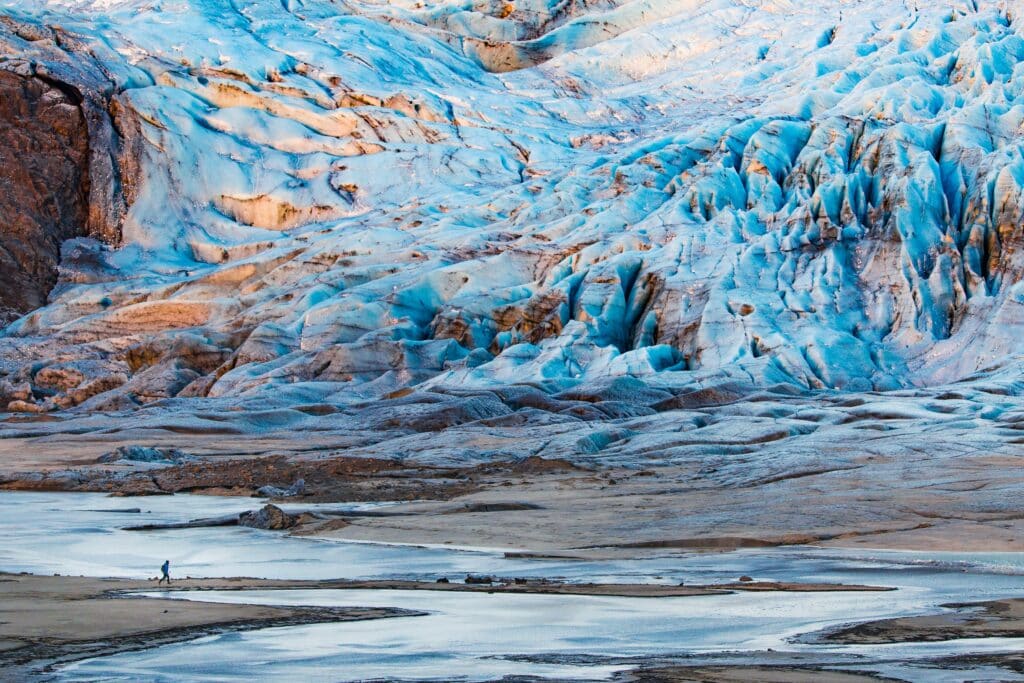
One of the most popular glaciers for a glacier walk in Iceland is Sólheimajökull, located near the village of Vík on the south coast of Iceland. The glacier is easily accessible and has a wide range of routes suitable for different levels of experience.
Other popular glaciers for glacier walks in Iceland include Vatnajökull, which is the largest glacier in Iceland and covers over 8% of the country, and Langjökull, which is the second-largest glacier in Iceland and has an ice cave that visitors can explore.
Glacier walks can be a fun and exciting way to experience the natural beauty of Iceland, but it’s important to note that they can also be dangerous if proper precautions are not taken. Visitors should always go with a reputable tour company and follow their guide’s instructions closely. Additionally, visitors should wear appropriate clothing and equipment, including sturdy hiking boots, warm layers, and crampons for walking on the ice.
Bath in the Reykjadalur Hot Spring Thermal River (‘Hot River’)
Reykjadalur Hot Spring Thermal River, also known as the “Hot River,” is a popular hiking destination in Iceland. Located in the town of Hveragerði, just a short drive from Reykjavik, the river is famous for its geothermal hot springs that provide a unique and relaxing experience for visitors.
The hike to the Hot River is approximately 3.5 kilometers long and takes about an hour and a half to complete. The trail starts in the town of Hveragerði and winds through the beautiful Reykjadalur Valley, offering stunning views of the surrounding mountains and geothermal areas.
Once you reach the river, you can soak in the natural hot springs, which range in temperature from 35-40 degrees Celsius. The water is rich in minerals such as sulfur, which is said to have therapeutic properties that can help soothe sore muscles and joints.

The Hot River is a popular destination year-round, with visitors enjoying the warm waters in both summer and winter. However, it’s important to note that the hike can be challenging during the winter months, as the trail can be icy and slippery.
Conclusion
Iceland is a beautiful country filled with endless opportunities for adventure and exploration. From hiking through stunning landscapes to relaxing in natural hot springs, there is something for everyone in this beautiful place. Whether you’re visiting for a short time or planning a longer trip, there are countless things to see and do that will leave you in awe of Iceland’s natural beauty and rich culture. In this list, we’ve provided just a tiny glimpse of the country and what you can expect.
If you’re reading this, I hope you’re able to take the leap and visit Iceland in the near future. It is one of the coolest places I’ve visited in the world and I can’t wait to go back and see even more of it!
Reed Sutton
Latest posts by Reed Sutton (see all)
- Review: Starlux Airlines Premium Economy (A350-900) - Jun 23, 2025
- Review: Hotel Proverbs Taipei, a Member of Design Hotels - Jun 18, 2025
- Review: ZIPAIR “Full Flat” Business Class (787-8) - Jun 4, 2025
- Booked: Morocco & Portugal 2025 - May 18, 2025
- Vancouver Miles & Pints Meetup (July 2025) - May 14, 2025
